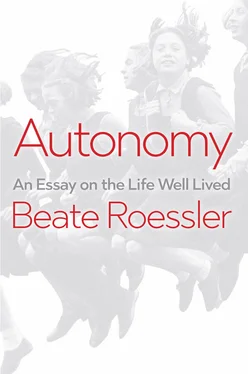Each of these forms of ambivalence could be paralyzing – if I really cannot decide, if I continue to vacillate between decisions and feel that I am incapable of doing or finding what I autonomously want. Consequently, ambivalence threatens my autonomy on its face because an action is only autonomous if it is really I who want to take that action. We saw in chapter 1that a person is autonomous when she has the opportunity and the capacity to determine herself how she wants to act or live. Ambivalence can undermine autonomy insofar as it is an expression of the fact that a person does not know how she should act, because she does not have a clear idea of what she wants, of which action – which behavior, which role – would really be hers . There may very well be everyday situations in which we experience ambivalence, but their potential power to threaten our autonomy can definitely reveal conflicts at the deeper levels of the structure of our desires and evaluations: ambivalence toward other people, toward the possible ways we might live our life, toward ourselves.
Up to this point, I have given only an overview of the various forms of ambivalence that can manifest themselves in behavior. Now I want to take a look at theories that more rigorously treat ambivalence as incompatible with autonomous action. As I said at the beginning, I am interested here in showing that the various forms of ambivalence do not have to be paralyzing, even if they sometimes can prevent us from acting, i.e. that there are good arguments for reasonably coping with enduring ambivalences.
Ambivalence as a disease of the will
An autonomous person can and should in no respect be ambivalent: this is what rigorous theories claim, and Harry Frankfurt is their most prominent advocate. It is freedom of the will that makes a person a person, not merely in the sense that she is free to do what she wants, but in the sense that she is also free to want what she wants. If a person has the action-motivating will that she really wants to have, then she is free. 18What does this “really” mean more specifically? An autonomous person knows what she really wants when she can stand resolutely behind her desire and when this conviction is ultimately rooted in the cares that define her and her self as a whole, deciding against which would mean giving up her identity. Frankfurt’s theory of autonomy and free will is thus at the same time a theory of the person – the self – and her psychological constitution. Hence it is no surprise that he repeatedly cites Luther, with his legendary dictum, “Here I stand, I can do no other,” as the model of an autonomous person. Luther knows what he wants. His convictions are so strong and binding that he cannot depart from his desire and his will even under life-threatening circumstances. It is precisely because of this idea, that we can only act autonomously when we act resolutely and decisively, that ambivalence becomes a problem, as it affects the structure of a person’s will. “Ambivalence is not a matter simply of having conflicting feelings,” Frankfurt writes. “It consists essentially in having a divided will – that is, of being unresolved as to which side of the conflict among one’s feelings one is on.” 19Because ambivalence attacks the structure of the will, he argues, it is a “disease of the will.”
Frankfurt, too, considers the first category of conflicts of ambivalence – simple prioritizations – to be the easiest: two conflicting desires cannot both be realized at the same time but, at best, only one after the other. My example above was the conflict between going to the movies and going to a concert, and Frankfurt likewise acknowledges that this conflict can be resolved relatively easily by putting the two desires in the proper order. The solution to such a conflict is therefore called integration . Any ambivalence of this sort can be completely eliminated in this way.
Conflicts in which this kind of integration is not possible are more complicated. My example above was deciding between two careers (poet or farmer). Another would be a person who has two conflicting emotions toward another person (admiration and contempt) and cannot decide which one to act on the basis of. Frankfurt characterizes both conflicts as genuinely internal as they concern the internal structure of the person’s will. Hence they cannot be resolved by integration but only by externalization , by cutting off . One of the two desires or volitions must be completely rejected. Once one has decided to do something, then the nature of the conflict changes. It is no longer a conflict between two desires within the person but a conflict between the person, who has completely and wholeheartedly identified with one desire, and the other, externalized desire. “‘[T]o decide,’” Frankfurt writes, “is ‘to cut off.’” He uses radical terms to buttress his explanation and resolution of the problem of ambivalence: “a radical separation of the competing desires, one of which is [. . .] extruded entirely as an outlaw.” 20Resolving ambivalence thus always means that the person has achieved a harmonious will structure because and insofar as the conflict has been externalized and thus rendered harmless.
For Frankfurt, the question of which of two conflicting desires a person decides in favor of is directly connected to his concept of the self: we cannot simply have the will we want to have but rather are bound to the reality of our character, our self. This reality is determined by what Frankfurt calls our inmost cares, that which is most important to us in life, our volitional necessities. Hence we must always understand ourselves as persons who describe the limits of our possible actions as the limits of our self. We not only must know exactly where we stand in a conflict between two volitions, we can know this. The playing field on which we make our decisions is thus clearly demarcated. We identify with a desire – we make a decision – always on the basis of these volitional necessities, which form the “essential character of [our] will.” 21
With his purist theory of coping with ambivalence, Frankfurt may well be right when it comes to paralyzing ambivalences, those that prevent us from acting, leaving us vacillating between two possibilities and unable to come to a decision. But do we not still end up deciding in most cases? And more often than not, do we not remain ambivalent in a certain sense, without actually vacillating or doubting our decision? Frankfurt seems too strict for such cases, and his demand for perfectly harmonious unity of the self unreasonable on phenomenological as well as on conceptual grounds: phenomenologically because we do not act or decide this way; conceptually because we do not need to describe this way what acting or deciding means .
Is an ambivalent will a healthy will?
We do not want to lose sight of what we are concerned with here, namely the question of whether ambivalences are compatible with personal autonomy given the fact that they are obviously part of our everyday life. One clear critique of Frankfurt’s rigorous rejection of the compatibility of autonomy and ambivalence comes from David Velleman, who argues that a completely harmonious will structure that has externalized all conflicting desires is in fact unhealthy. 22Ultimately, Velleman contends, Frankfurt proposes suppressing non-motivating desires or volitions, removing them as much as possible from our “volitional complex,” thus establishing what for Velleman is only a seeming harmony and consistency of second- or higher-order desires. According to Velleman, what Frankfurt describes here as healing the will – namely, suppressing or rejecting conflicting desires – Freud diagnosed as an illness. Hence it is precisely not ambivalence that constitutes a disease of the will, but the externalization, suppression, and rejection of those desires that produce conflict.
Читать дальше












